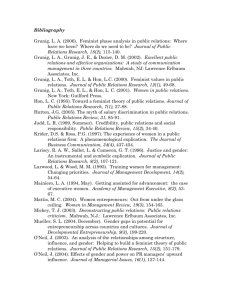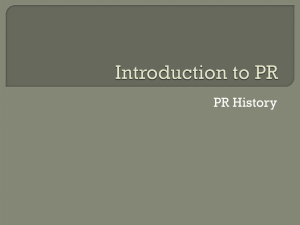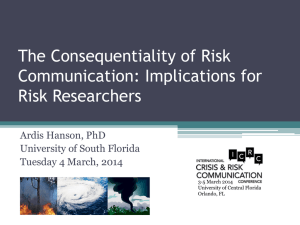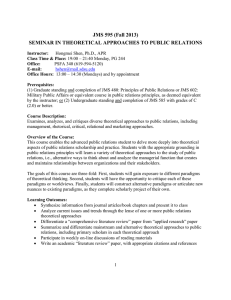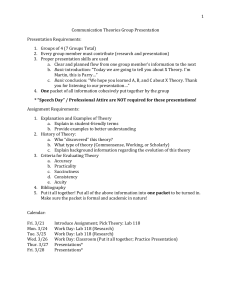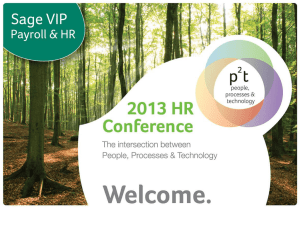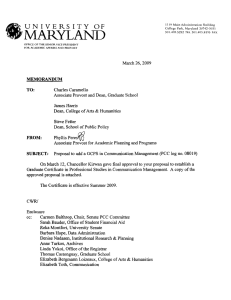Lect 2 History and Theory - Mayank
advertisement
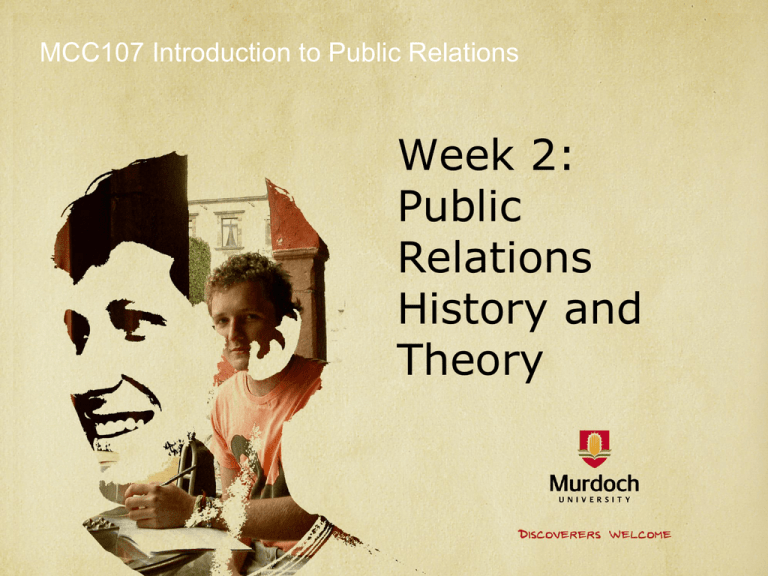
MCC107 Introduction to Public Relations Week 2: Public Relations History and Theory A brief history lesson • PR is not a new discipline. It’s origins span as far back as Ancient Egypt and beyond. • One view is that Ancient Greecian rhetorical theory, the cornerstone of persuasion and the basis of Aristotle’s work 2000 years ago, was the beginning of modern day PR. • This view is supported by modern day rhetorical and critical PR theorists such as Robert Heath. • PR, public speaking and the art of oratory have often been linked. Why theory? • To reflect on public relations practice • To ‘deconstruct’ public relations • To develop public relations as an ethical profession Grunig & Hunt’s four models (1984) Press agentry/ publicity Public information 2-way asymmetric 2-way symmetric ‘Excellent’ Public Relations Propaganda Craft PR Press agentry Journalism Public information Professional PR Asymmetrical 2-way asymmetric Symmetrical 2-way symmetric Limitations • Suggests progressive, developmental hierarchy • Focuses on organisational PR • Ignores contextual/environmental factors • Ignores power (particularly in assumption of symmetry) • Ignores international contexts – culture, politics etc Asian approaches to public relations • Attempt to adapt Grunig & Hunt’s four models • Develop additional models: personal influence, cultural interpreter • Argue the need to take social and political factors into account • Theorists include Krishnamurthy Sriramesh Rhetorical theory • • • • Considers how the role of public relations as persuasive discourse Suggests dialogical relationship Allows consideration of written texts/language use, and of ethics Theorists include Steve Mackey, Robert Heath & Anne Surma Critical theory • • • • Highlights influence of power in communication Critiques social, institutional, political & corporate structures Seeks social change Theorists include D. Holtzhausen, Kay Weaver & Jacqui L’Etang Law • Tension between legal and public relations roles • Defamation – anything damaging to someone’s reputation which is published or broadcast to a third person • Contempt of court – comment on anything before the courts Ethics www.pria.com.au • Ethics is about values • Code of ethics is not enforceable • Industry needs ongoing education programs Propaganda and Public Relations • Propaganda: unacceptable manipulation of public opinion • www.prwatch.org • www.spinwatch.org • Media Watch, ABC TV Public relations vs marketing Publications Market assessment Customer segmentation Customer relations Product development Advertising Sales Customer/ employee research Corporate advertising Image/ reputation Media relations Community relations Issues management Lobbying Social investments Role of the writer • ‘to communicate with the public’ (Newsom & Carrell 2001:7) • PR writers need to understand publics, channels of communication, and organisation • Publics are different from markets, audiences Public relations activities • • • • • • • Public affairs Lobbying Community relations Media relations Internal communication Sponsorship/CSR Event management Further reading Grunig, J & Hunt,T. 1984. Managing Public Relations. Orlando, FL:Holt, Rinehart & Winston. Grunig, L., Grunig, J. & Dozier, D. 2002. Excellent Public Relations and Effective Organizations. Mahwah, NJ: Lawrence Erlbaum Assoc Further reading II Mackey, S. 2003. Changing vistas in public relations theory. PRism, 1. available http://praxis.massey.ac.nz/vista.html (accessed 30/7/06) Handouts in tutorials 1. Weekly grammar exercises
